Empirical Exercise 14: Female Committees
1/16
There's no tags or description
Looks like no tags are added yet.
Name | Mastery | Learn | Test | Matching | Spaced |
|---|
No study sessions yet.
17 Terms
question, hypothesis, answer
Question: Does the gender composition of hiring committees affect the success rate of female candidates in public judiciary exams in Spain?
Hypothesis: Female candidates are more likely to succeed when evaluated by committees with more women.
Theory:
Direct mechanism: Women who are hired to top-level positions (perhaps due to gender quotas) recruiting more females than their male counterparts.
Female employers may be more favourable towards female employees
Indirect mechanism [not tested here]: role model effect of women in visible positions encourages others to aim higher
data info, variables, population model
observation of 309 committees
Cross section of committees
Exams have oral and written parts: committee decide after majority vote whether they passed: passing is necessary but not sufficient
Each candidate was assigned numerical grade
More passing grades than positions, final grades were ranked, positions given to best candidates
All public exams during a 20 years: 1987-2005
6 committees per exam, size of committee varies per exam eg 2/3 ppl for notary and 10 ppl for judge
Main dependent variable yce: stands for specific committee in an exam
Measure of the success of candidates who took exam e and were evaluated by committee c
Main independent variable genderce is a measure of the gender composition of the committee c in exam e
λe is an exam fixed effect: one dummy for each one of the 51 exams between 1987 and 2007 eg judge exam in 2003, judge exam in 2004, notary in 2004
Positionce is the (log) number of positions assigned to committee c in exam e
only set number of positions to fill every year even if candidate does very well, they might not get im
allocation of candidates to evaluating committees
random eg ranking of candidates in alphabetical and numerical order + lottery matching initial letters of candidates numbers of committees
Has nothing to do with gender, not more likely being female will imply a lot of female examiners get to examine you as a female
Randomness of the match between examiners and candidates is within exams but not across exams
Within exams: assigned to committees within same exam eg judge in a specific year
Across exams:eg judge exam in 2001 and notary exam in 2003: gender composition of committees not randomly assigned
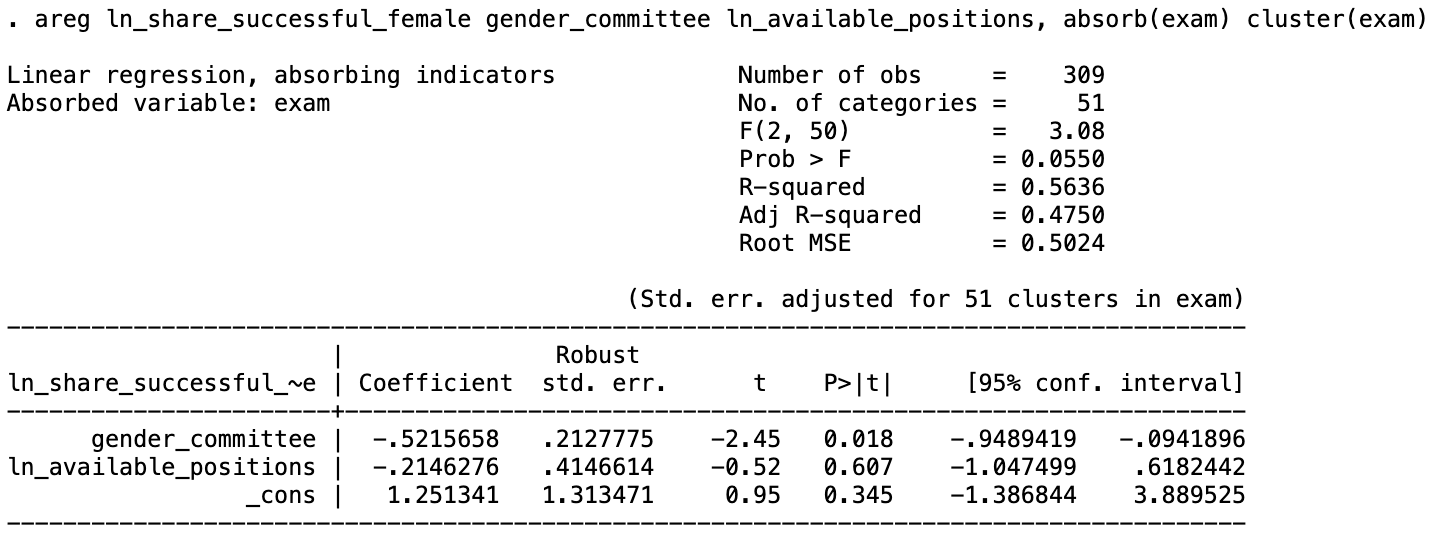
-dependent variable: share of female candidates among successful candidates
-controlling for log of available positions and exam fixed effects
-no of female evaluators has significant negative effect of % of successful female candidates
female evaluators are either tougher on females or male evaluators more lenient on females
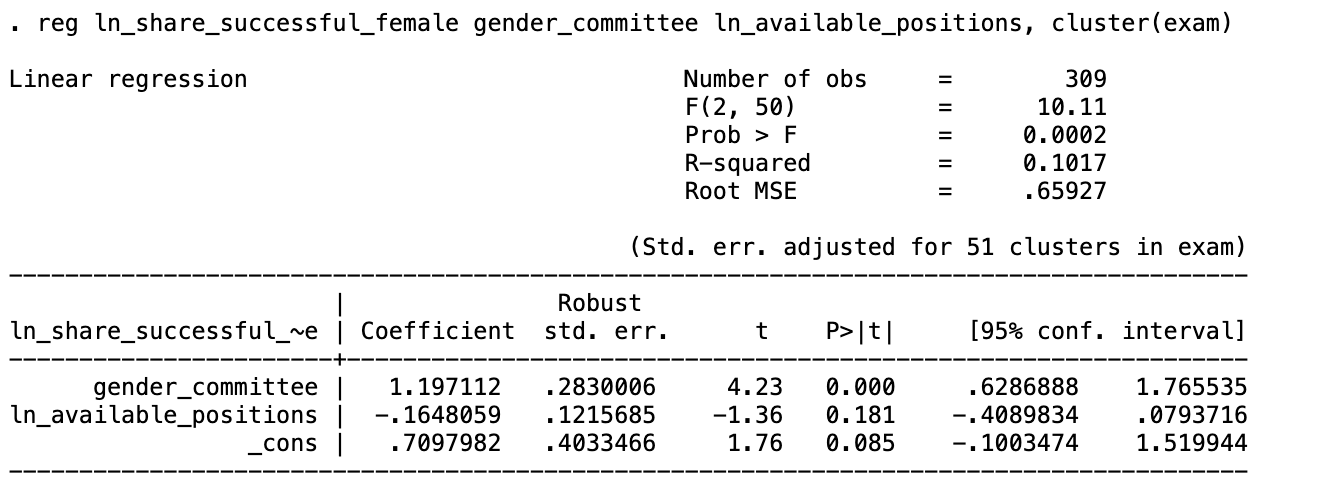
-taking out exam fixed effects
-can no longer benefit from random assignment of candidates to committees: as they are assigned randomly within not across exams
-coefficient changes sign
-have to control for exam fixed effects as it reduces variation
what happens when you don’t control for exam fixed effects
-notaries are typically men and court secretaries are much more likely to be women
-if you don’t control for exam fixed effects, type of job becomes omitted variable in error term
-affects percentage of female hired in composition interviewing panel
-randomness [caused by lottery] is only within an exam so have to control for exam to eliminate any potential bias
-no random allocation across exams as we are not controlling for the same exam across years
discretising gender
Genderce is a continuous variable
Can discretise the continuous variable: converting it into a set of dummy variables
Can split range of value the variable can take into percentage intervals of how many women eg 0-10%, 10-20% etc
-5 dummies, interval 0 is the omitted group
-so put interval 1-5: 5 dummies
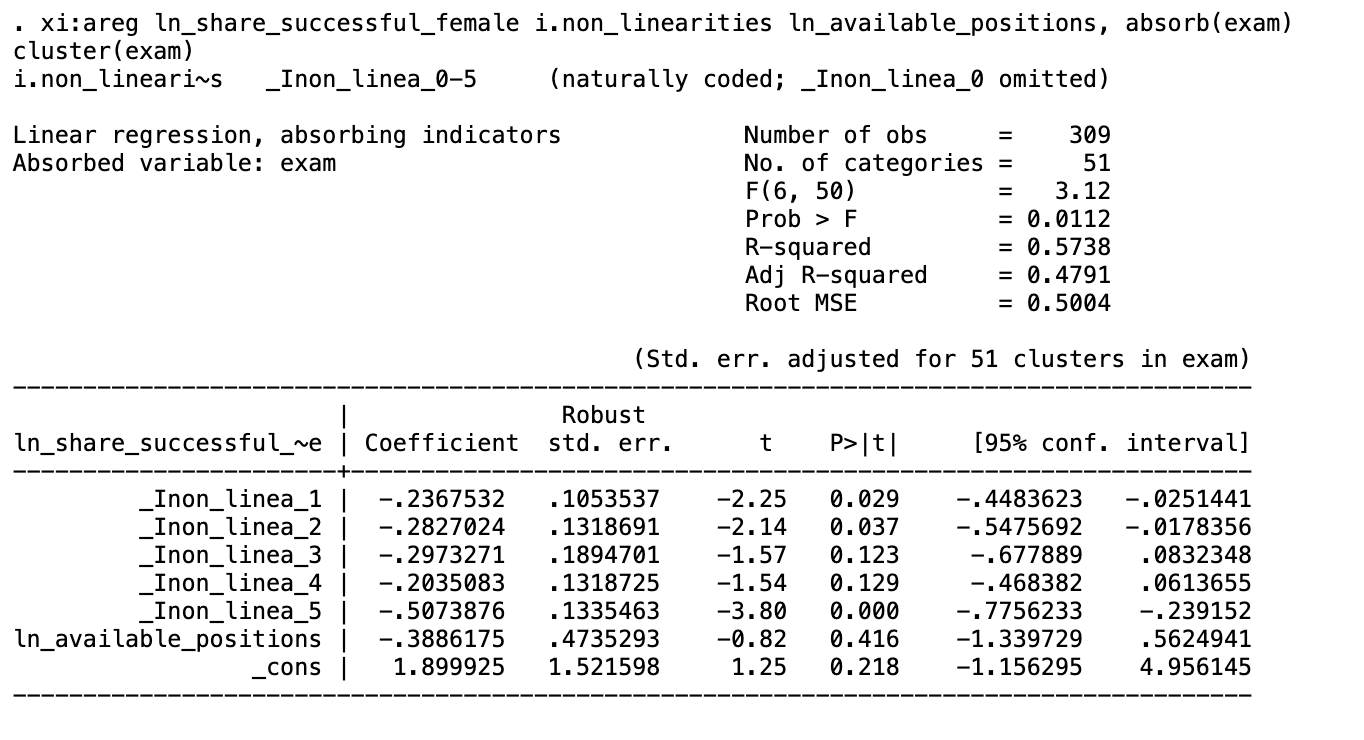
-considering non-linear effect of gender composition
-regressing share of successful females on dummies capturing diff female shares 0.1-0.2, 0.2-0.3 etc up to <0.5
-omitting female share= 0: so coefficients are relative to no women
-share of successful female candidates increase by 24% when all male committee
-estimated coefficients are similar when you have one woman on committee: increasing female evaluators doesn’t affect female success until they are in majority
-large significant effect: success of females decrease by 5.1% when female majority committee

-dependent variable: log number of female candidates
-as no of female evaluators increase, significantly lower no of successful female candidates
-exam fixed effects
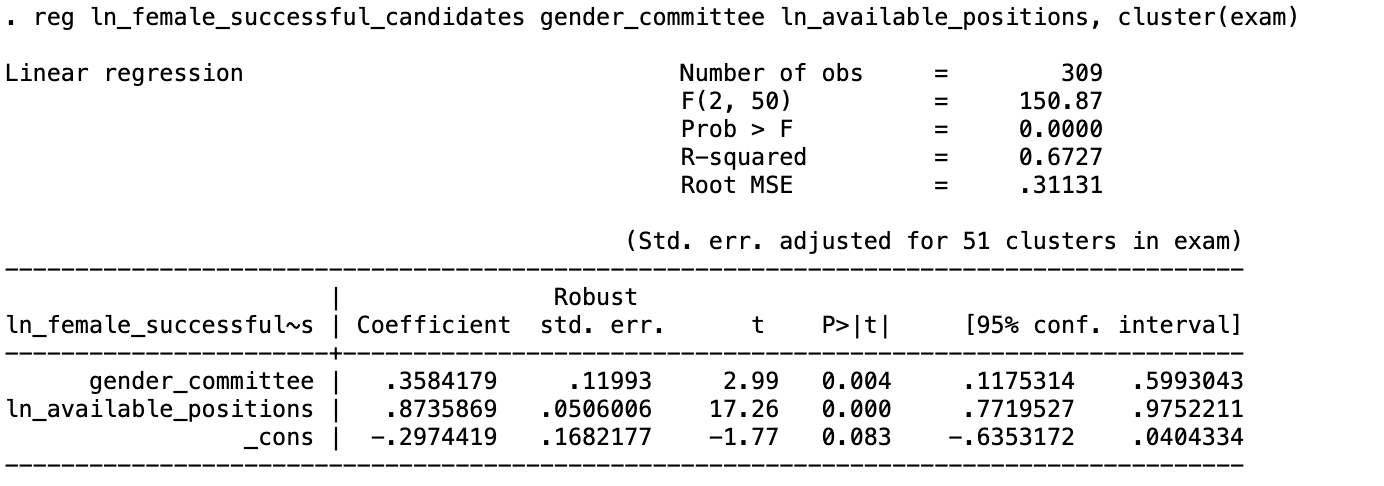
-without exam fixed effects, estimate becomes positive
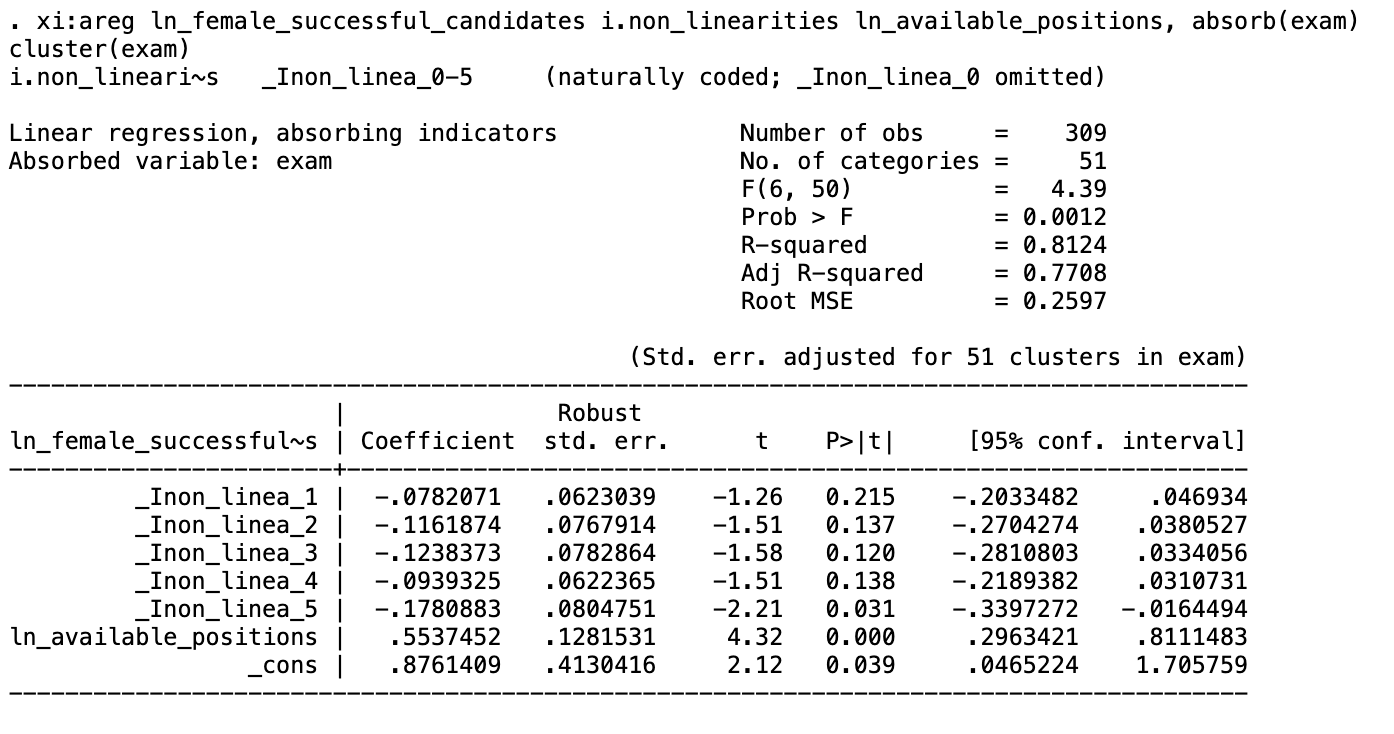
-non linear relation of number of female candidates
-female candidates 8% more likely to succeed when evaluated by all male vs female women on committee: not significant so no diff in all male vs one female evaluators
-estimated coefficients for other groups small: additional female evaluators don’t affect candidates chances [insignificant] until they are in majority [significant]
-18% lower chance of success with female majority

-if positive but female<50%, minority dummy =1
-if committee > equal to 50% females, majority dummy =1
-tend to do better when less women on committee but not significant
-repeated for log of share of successful female candidates as well
controlling for other variables
-even though committees are randomly matched with candidates (within an exam), this is different from arguing that the gender of the committee's examiners is ’exogenous’
-could be that differences in the gender composition of committees are associated with differences in other committee characteristics
-eg female examiners are on average younger and that it is young examiners that make it disproportionately difficult for female candidates to succeed
-can introduce controls eg other committee characteristics: the mean age of members, their mean ranking, and their mean experience as evaluators
-the effect of the female composition of the committee is not significantly affected by the inclusion of these additional controls. Therefore, these findings are reassuring, it seems that our previous results were not caused by these committee characteristics.
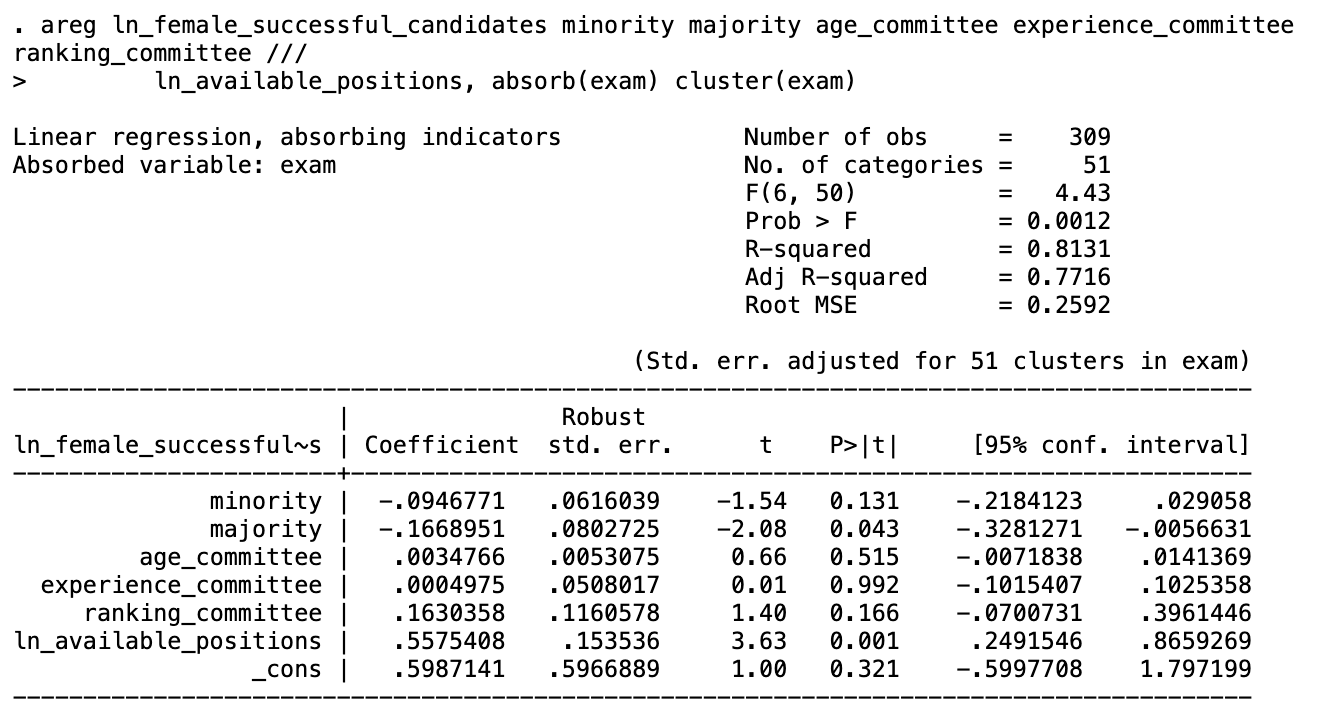
-additional controls: effect of female composition on committee not significantly affected by controls
-age and experience do not playa. role as estimate is same as above in group 5, not biased -0.17
-repeated for log of share of successful female candidates as well
-the effect of the female composition of the committee is not significantly affected by the inclusion of these additional controls. Therefore, these findings are reassuring, it seems that our previous results were not caused by these committee characteristics.
conclusion
Our findings suggest that replacing male decision-makers with female decision makers will not increase the number of women in second-tier top positions, at least through the direct mechanism of being more likely to hire them.
internal validity
Random assignment of candidates to committees within each exam ensures that the committee composition is not influenced by candidate quality.
Use of exam fixed effects controls for variation between exams.
Omitted variable bias: Female committee members might differ in other ways (e.g., age, seniority).
Addressed by controlling for committee member age, experience, and ranking, which don’t have significant impact
Non-random assignment of evaluators across exams: This limits causal inference across exams but not within.
external validity
Context specific: results are drawn from judicial exams in Spain, which are highly structured, objective, randomized in candidate assignment, but not in committee composition.
May not generalize to:
Informal or non-standardized hiring processes
Other professions or countries
Private sector evaluations